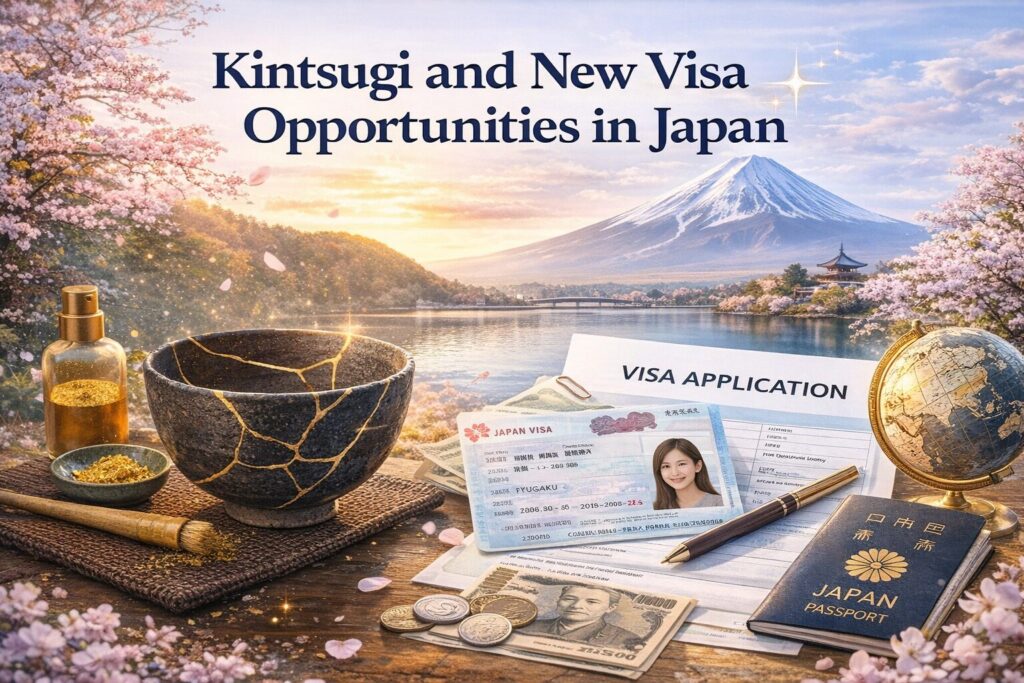コンテンツ

Summary
Kintsugi is a revered Japanese craft tracing back to the 15th century, where broken ceramics are mended with lacquer and then beautified with precious metals like gold or platinum. This art appreciates the beauty in imperfection and deterioration over time, embodying the ‘Wabi-Sabi’ philosophy. Recently, it has seen a resurgence, particularly among young women, as a home activity during the 2020 pandemic.
The golden joints created in this process, referred to as ‘landscape,’ can sometimes enhance the value of antique tea bowls to a point where they become more valuable than their intact counterparts. The process of Kintsugi is personal and varies greatly from individual to individual, with no established lineage or fixed rules, allowing for a rich diversity in styles and approaches.
Furthermore, this document discusses new visa opportunities in Japan, aimed at attracting foreign nationals from top-ranked universities globally for job-seeking and entrepreneurial activities for up to two years. These visas also facilitate paid internships and allow visa holders to bring their family members along. Additionally, there’s an option for a long-stay visa for wealthy individuals seeking an extended stay for sightseeing and recreation, with a stay up to six months, fostering cultural exchanges without the involvement of income-based activities.
Have you ever seen or heard of ‘KINTSUGI’ ?
Kintsugi is a traditional Japanese technique for repairing broken or cracked ceramics and porcelain and is said to have existed since the Muromachi period in the 15th century. In this technique, natural materials such as lacquer are used to repair the damage, after which metal powders such as gold or silver powder are sprinkled over the joints to decorate them beautifully.
Broken or chipped ceramics are glued together with lacquer and the joints are decorated by sprinkling gold, platinum or other metal powder. The joints are called ‘landscape’, and antique tea bowls with gold joints are sometimes more valuable than those with gold joints.
Various traditional techniques have existed in Japan since ancient times. Kintsugi, which beautifully revives chipped ceramics, is one such technique.
The popularity of kintsugi surged as an entity that could be enjoyed in a stay-home setting at the same time as the spread of the coronavirus in 2020. After a period of self-restraint following the coronavirus disaster, kintsugi experiences are now becoming increasingly popular in Japan, especially among young women.
Kintsugi represents the Japanese way of looking at things and beauty, the ‘Wabi’ and ‘Sabi’. “Wabi” refers to imperfection, while “Sabi” refers to deterioration over time. The sense of “wabi-sabi”, that although imperfect, beauty takes over as time goes by, is also expressed in kintsugi.
Rather than making it less noticeable, the broken appearance is utilised to make it stronger, more beautiful and easier to use. This is called being apologetic, and this is the Japanese way of looking at things.
In fact, there is no traditional lineage in kintsugi, and each person does it in their own way. Lacquer craftsmen have been asked to repair kintsugi, and no one has made kintsugi as their sole profession. As there are no rules on materials and techniques, there are many different types of kintsugi, depending on the person’s aesthetic sense.
At present, kintsugi workshops are available in several places in Japan. After completing the kintsugi experience, visitors can also enjoy a ‘kintsugi walk’. While strolling around Omotesando Hills, a complex of shops and residences, and Cat Street, a promenade lined with high-brand and unique shops, you can experience the depth of kintsugi and the history of Omotesando through the explanations of a professional kintsugi artist.
Why Japanese kintsugi is a hot topic abroad
Kintsugi is a craft known to less than half of the Japanese population, but it has been widely recognised and appreciated overseas as ‘too good to be true’. and are shocked and appreciative of it. Why does it attract so much attention? It seems to be because they feel that the reversal of the idea of repairing dishes that could have been thrown away and making the scratches stand out is unique to the Japanese.
Usually, “repair” refers to various items such as bags, shoes, watches, clothes, etc., but the basic idea is to repair them so that the damage is not noticeable, just as they were originally. However, kintsugi is an idea that foreigners cannot imagine: instead of emphasising the damaged part, it is decorated with gold powder, a gorgeous and expensive material, making it more valuable as a new art form! Lovely! And since the Japanese have long held the ideas of ‘wabi-sabi’ and ‘mottainai’ (wastefulness), the combination of these with the repairs made by kintsugi gives an indescribably bewitching and beautiful feeling. This is the very spirit and heart of Japan.
The fact that Kintsugi is highly regarded by foreigners can be seen from the results of Google trends and the increasing frequency with which famous people and companies use the word ‘Kintsugi’.
There are two examples of how ‘kintsugi’ became famous in 2020-2021.
First, UN Secretary-General Antonio Guterres attended the International Day of Peace on 17 September 2020 and said that the Japanese philosophy of finding beauty in broken things should guide today’s fractured world as it seeks to end the global Covid-19 pandemic.
Second, at the closing ceremony of the Paralympic Games, International Paralympic Committee (IPC) President Andrew Parsons mentioned kintsugi in his closing remarks. In his speech, he introduced kintsugi as a way of embracing imperfection and valuing it rather than hiding it, and said that it shared the same philosophy as the Paralympic Games.
It turned out that kintsugi has become one of the booming trends in the UK and in other European countries. A search for ‘kintsugi books’ on Amazon UK turned up 150. One of these books is a Bible with a kintsugi-like cover.
Foreigners wanting to experience kintsugi
Since the pre-covid period, when inbound demand in Japan was rising, many foreign tourists visiting Japan wanted to experience kintsugi as an activity! Many of them said that they wanted to experience kintsugi as an activity. However, as kintsugi repair has been carried out by artisans in a very small way, there were few people who could speak English, and there were few kintsugi shops, so many foreigners had to give up the kintsugi experience.
Those foreigners who were not able to experience kintsugi were tempted to write down their kintsugi vessels as souvenirs! However, kintsugi, which are all one-of-a-kind pieces that take a lot of time and effort to produce, were not sold very often.
Nowadays, more and more English-language kintsugi classes are being offered for foreign tourists.
Who wants to learn kintsugi in depth?
How can one learn the philosophy and techniques of kintsugi while living in Japan under a kintsugi master, not only for a short period of time, but for a longer period of time?
There are three possible visas.
Cultural activities visa
The cultural activity visa(Bunka Katsudou: 文化活動)is designed to accept researchers of Japanese culture and trainees of traditional Japanese skills from abroad. It allows for academic or artistic activities that do not involve income, or activities to conduct specialised research or receive guidance from experts in the unique culture or arts and crafts of Japan, and to acquire these skills.
A cultural activities visa is required for any of the following activities;
- Academic activities not involving income.
- Artistic activities not involving income.
- Activities to conduct professional research on culture or arts and crafts unique to Japan.
- Activities to receive guidance from experts in culture or arts and crafts peculiar to Japan and to master them.
For example, foreign university professors, assistant professors, lecturers, etc., who conduct research or surveys without earning income in Japan, but who also specialise in researching not only kintsugi but also ikebana, tea ceremony, judo and other unique Japanese cultures and arts, or who receive private instruction from experts in these fields.
In the case of a foreigner who wishes to acquire the culture or arts peculiar to Japan under the guidance of a kintsugi expert, a license, thesis, collection of works, CV, etc., which clarify the background and achievements of the expert concerned, is required.
J-FIND visa
Japan System for Future Creation Individual Visa (J-Find): Foreign nationals who have graduated from one of the top 100 universities in the world university rankings will be granted “Designated Activities (Future Creation Individual Visa),” 特定活動(未来創造人材)a status of residence that allows them to engage in job seeking activities in Japan for a maximum of two years.
Specifically, graduates of universities ranked in the top 100 in two or more of three different university rankings issued by the world institutions will be eligible. They will also be allowed to work, which will enable them to participate in paid internships. During the two years of their stay in Japan, they will be able to prepare for job hunting and entrepreneurship. They will also be allowed to work for a period of time until they find a job, and they will be allowed to bring their family members with them. The students must be within five years of graduating from an overseas university, and there is no age limit.
Long-stay visa
Normally, visas for tourism purposes are granted for a maximum stay of 90 days in Japan, but did you know that only wealthy nationals who meet certain conditions can obtain a six-month Long Stay visa?
This visa type is called “Designated Activities” No.40 (Long Stay for sightseeing and recreation 特定活動-告示40号) visa.
What is of concern is the restriction of activities, but according to the view of the Office of the Immigration Counsellor of the Ministry of Justice, it is of course not possible to work, but tourism and recreation are not a problem, and cultural activities that do not involve income are also considered to be possible.
More detail for Long-stay visa
Which visa you choose depends on your background and the specific case. Although these visas allow you to stay in Japan for a long period of time, after you have mastered the art of kintsugi, you may decide to change to a work visa or business visa, or return to your home country, depending on your future plans. Therefore, you will need to make plans for the future.
Other Question?
Please feel free to contact us for advice!
First, please call +81-3-6264-9388 or leave a message on our website with your inquiry. (Please contact us by phone or consultation page.)
TEL: +81-3-6264-9388
WeChat: visa_hengshan
Line ID: visa_yokoyama
Email: info@lawoffice-yokoyama.com

![JAPAN VISA [YOKOYAMA LEGAL SERVICE OFFICE]](https://lawoffice-yokoyama.com/wp/wp-content/uploads/2014/10/logo_024.png)

